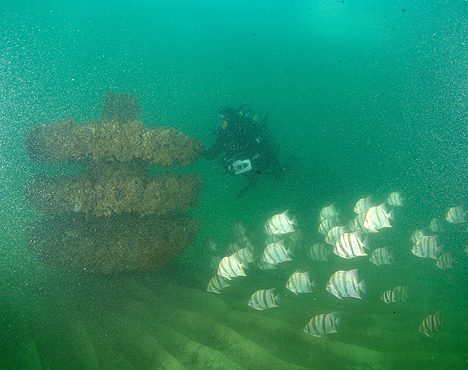
New organization forming great plans
Santa Rosa Beach resident Andy McAlexander is on a mission, and it’s a big one. With plans to bring artificial reefs near shore in the Gulf of Mexico and oyster habitat restoration to the eastern Choctawhatchee Bay, McAlexander has bright ideas for South Walton’s fishing, diving and environmental future.
As founder of the newly formed non-profit organization, South Walton Artificial Reef Association (SWARA), McAlexander’s plans are starting to come to fruition. For the past six months, McAlexander has been researching, attending seminars and learning about the benefits artificial reefs bring to our environment. With mentoring and assistance from the Mexico Beach Artificial Reef Association, McAlexander has developed a plan to install 18 environmentally safe reefs near shore in the Gulf and in the Choctawhatchee Bay. The plan includes:
• Five oyster habitat restoration sites in the eastern portion of the Choctawhatchee Bay
• Four snorkeling reefs straddling the coastal sandbars
• Nine fish habitat and skin diving reefs ½ – 1 mile offshore.
Download image of proposed reef sites
“In an area where the Gulf bed is 95 percent barren sand flats, the reefs will create near shore, family oriented recreational activities, including human propelled fishing (standup paddleboards and kayaks), skin-diving, and snorkeling attractions. Educational objectives include biological awareness and marine research studies,” McAlexander said.
Our artificial reefs support more than just fish according to University of Florida Sea Grant. They support jobs and people that earn a living from tourism associated with diving and fishing. In 1998, Florida State University researchers estimated fishing and diving activities supported nearly 8,136 jobs and 84 million dollars in salary each year in Escambia, Santa Rosa, Okaloosa, Walton, and Bay counties. Despite the age of the study, it provides an idea of how vital artificial reefs and marine recreation are to Northwest Florida.
Walton County lags far behind the rest of the State of Florida that boasts more than 2,700 reefs along its coastline. Of the 600+ reefs in Northwest Florida, Walton County has four offshore reefs with two more currently in the permitting process.
It is a lengthy and costly process. Permitting must go through U.S. Department of Defense, U.S. Department of Homeland Security, U.S. Environmental Protection Agency, U.S. Department of Commerce, Florida Department of Environmental Protection and Walton County. The permitting goes through Walton County and takes up to 18 months. McAlexander is optimistic the seed money will come through the South Walton Tourist Development Council. And with support from the Walton County Board of County Commissioners, the future looks bright.
To learn more about SWARA, click here.
Below is a video of East Pensacola reef installed in 2011:
